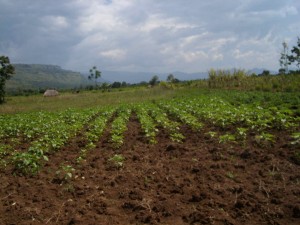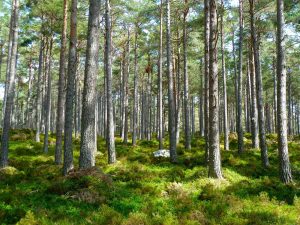 Over the last few weeks we’ve introduced you to some new faces on the GfGD blog, including Robert Emberson, Heather Britton and Jesse Zondervan. Today, Robert (based in Victoria, Canada) writes on the connections between soil erosion and sustainable development, and poses the question – is soil one of our most threatened resources?
Over the last few weeks we’ve introduced you to some new faces on the GfGD blog, including Robert Emberson, Heather Britton and Jesse Zondervan. Today, Robert (based in Victoria, Canada) writes on the connections between soil erosion and sustainable development, and poses the question – is soil one of our most threatened resources?
When we talk about sustainable energy sources, most of the time we’re referring to renewable sources of electricity and heat. Geothermal, solar, wind or waves – these are all sources of energy that are, within practical limits, not exhausted by our use. However, all living species need more than just electricity and heat as energy; we need food to sustain us.
The vast majority of food for humans requires agriculture, whether vegetable crop or grazing species. Agriculture depends completely on fertile soil to succeed, but we often don’t think about soil as a resource that really matters. Crucially, however, the rate at which soil forms is vastly outpaced by the rate it erodes away in modern farming. For all intents and purposes, soil is a non-renewable resource, like fossil fuels.
A recently published UN study has highlighted this, estimating that 24 billion tons of fertile soil is lost annually every year – primarily in sub-Saharan Africa. The implications for sustainable production of food are obvious, with some studies suggesting we only have an average of 60 years’ worth of harvests left under the current practices.
We shouldn’t ignore the inherent potential of this crisis to exacerbate existing economic inequalities, too; according to the study authors “critically unbalanced land productivity trends in African cropland and grasslands are particularly concerning given expected population growth.” This, in fact, highlights the most worrying trend; even as soil is eroded away, and the amount of cropland dwindles, the global population increases apace, with 9 billion mouths to feed estimated by 2050.

Farming in Uganda (Source: GfGD)
Moreover, the UN study emphasises that degradation of soil and loss of agricultural land increases the competition for already-scarce resources, which could lead to mass migration or social instability, further increasing the difficulty of implementing sustainable solutions.
So how has the problem become so acute? It is useful to first explain how soil erosion occurs naturally, before thinking about how humans have impacted the natural cycles. Roughly, natural soils form as the result of chemical breakdown of underlying bedrock, supplemented by organic matter decaying from dead plants and animals. In a stable system, the rate at which soils are produced is in balance with the rate at which water washes away surface material during floods and storms.
In some parts of the world, where warm, wet, conditions are ideal for plant growth and chemical reactions, soil can grow extremely fast – as much as 2.5mm per year, although the global average is nearer to 0.1mm per year.
Water is the primary agent that erodes the soil. Whenever rain falls, droplets can dislodge material, and these can be washed away downhill or carried in floodwaters over landscape. It’s no surprise, then, that soils through which water can more easily infiltrate are less likely to lose material to overland flow. However, humans have fundamentally altered this balance.
Natural forests allow water to infiltrate into soil quickly, but without root systems and porous soil this can be much lower. For example, in Wales scientists demonstrated that forested plots had infiltration rates 67 times faster than sheep pastures. Agricultural land is similar, or can be worse; if there are no crops to bind the soil together for some parts of the year, or if ploughing churns up the soil and allows material to be easily washed away, topsoil can be severely depleted in a single flood.
These two factors – lack of plant cover, and extensive tillage – are hallmarks of high intensity farming globally, but as the UN study points out, while this kind of farming has increased productivity over the last decades, it is increasingly unsustainable. Addition of fertiliser has increased the productivity, but masked the degradation of arable land. Moreover, in some regions it creates a viscous cycle, where loss of productive land leads to deforestation to access untapped soil.
 Forests are key buffers against many slow and fast moving disasters; they can limit flooding, by encouraging water to infiltrate rather than running over landscape, and in doing so can allow more water to reach aquifers – thus limiting drought later. They also serve important roles in stabilising hill-slopes against landslides, and slow desertification. Given how long it takes for forest to regrow, it seems clear that the impact of soil loss will be felt for years to come.
Forests are key buffers against many slow and fast moving disasters; they can limit flooding, by encouraging water to infiltrate rather than running over landscape, and in doing so can allow more water to reach aquifers – thus limiting drought later. They also serve important roles in stabilising hill-slopes against landslides, and slow desertification. Given how long it takes for forest to regrow, it seems clear that the impact of soil loss will be felt for years to come.
So what can be done to prevent it? And how can geologists act to help address the problem, particularly how we can still achieve sustainability goals in the face of the rapid loss of life-giving topsoil? An integrative approach is certainly important. Soil is the interface where life, at a microbial and macro-scale, coexists with physical and chemical processes in the bedrock. Understanding how all of these fit together is crucial to build a clearer picture of the at-risk soil.
Sustainable rehabilitation of agricultural land has been achieved at a wide scale in some countries, like Ethiopia. Surface process geologists could help by producing maps of local and regional propensity for erosion, to help guide these efforts. Scientists from the Kenya-based World Agroforestry Centre have been hard at work producing for the first time maps of soil chemistry and health across sub-Saharan Africa, and these should similarly help to more efficiently utilise the soil for particular crops, and aid in crop choice for a given location, if appropriately combined with crop biology assessments.
The authors of the UN study explain that increasing the efficiency of agriculture would certainly alleviate some of the stress on croplands. Improvements in efficacy can be found at different points throughout the food supply chain; for example, the authors write that:
“Eliminating food waste would reduce the projected need to increase the efficiency of food production by 60 per cent to meet expected demands by 2050”.
Meat uses five times as much land for a given nutritional intake than the comparable vegetable option, so reducing the intake of meat, along with other nutritionally inefficient crops (like soy and palm oil) would distinctly reduce the amount of cropland needed to feed 9 billion people. These solutions are politically sensitive, of course, but scientists can make informed decisions about their own food choices, and encourage others to do the same.
Above all, given how important soil is to land surface processes, many geologists could ask themselves which aspects of their own knowledge might help alleviate this significantly under-reported problem. While we have alternative, renewable energy sources to turn to instead of fossil fuels, we don’t yet have an alternative to soil, and as such it’s perhaps imperative to think about soil as one of our most threatened resources.
Robert Emberson is a science writer, currently based in Victoria, Canada. He can be contacted via Twitter (@RobertEmberson) or via his website (www.robertemberson.com).
**This article expresses the personal opinion of the author. These opinions may not reflect official policy positions of Geology for Global Development.**
